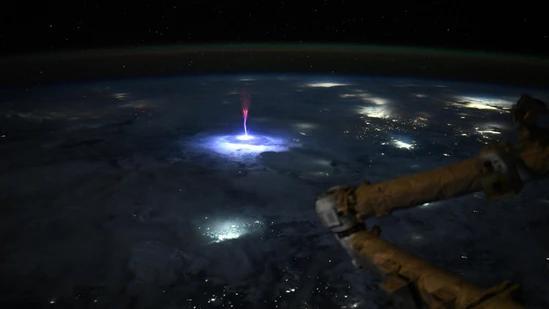
NASA Astronaut Captures Rare ‘Sprite’ Lightning Over US & Mexico
In a rare and awe-inspiring phenomenon, NASA astronaut Nichole Ayers has captured a stunning image of a “sprite” lightning bolt from the International Space Station while orbiting above the United States and Mexico. The photograph showcases a brief burst of light, known as a Transient Luminous Event (TLE), that occurs above thunderstorms.
Ayers, an astronaut and research scientist, shared the remarkable image on social media, sparking widespread interest and excitement among scientists and space enthusiasts alike. The sprite, a type of TLE, is a rare atmospheric phenomenon that has puzzled researchers for years. Its capture by Ayers provides a unique opportunity for scientists to study this phenomenon and gain a better understanding of its relationship to thunderstorms.
What are Sprites?
Sprites are a type of TLE, which are brief bursts of light that occur in the upper atmosphere. They are characterized by their rapid development and short-lived nature, typically lasting only a few milliseconds. Sprites are often associated with thunderstorms, but they can also occur above other types of weather systems, such as squall lines and fronts.
The exact mechanisms behind sprites are still not fully understood, but scientists believe they are related to the electrical discharges that occur within thunderstorms. When a thunderstorm becomes intense enough, the electrical discharges can penetrate the cloud and reach the mesosphere, a region of the atmosphere about 50-80 kilometers above the Earth’s surface. Here, the discharges can interact with the atmospheric gases, producing the bright flashes of light known as sprites.
Nichole Ayers’ Capture
Ayers’ capture of the sprite is a significant achievement, as it provides scientists with a unique opportunity to study this rare phenomenon. From her vantage point on the International Space Station, Ayers was able to capture the sprite in all its glory, revealing its characteristic wispy tendrils and vibrant colors.
The image was taken using a specialized camera system, which is designed to capture high-resolution images of the Earth’s atmosphere. The camera is equipped with a range of filters and sensors that allow Ayers to capture a wide range of atmospheric phenomena, from clouds and hazes to aurorae and TLEs like sprites.
Scientific Significance
Ayers’ capture of the sprite has significant implications for scientists studying TLEs and their relationships to thunderstorms. By analyzing the image and other data collected by the camera system, researchers can gain a better understanding of the mechanisms behind sprites and how they fit into the broader context of atmospheric physics.
“Scientists can use these types of photos to better understand the relationship of TLEs to thunderstorms,” Ayers explained in a statement. “This can help us improve our understanding of the complex interactions between the atmosphere and the Earth’s surface.”
The capture of the sprite also highlights the importance of space-based observations in understanding the Earth’s atmosphere. From space, researchers can gather data on atmospheric phenomena that would be difficult or impossible to collect from the ground. This data can be used to improve weather forecasting, monitor climate change, and better understand the complex interactions between the atmosphere, oceans, and land.
Conclusion
Nichole Ayers’ capture of a rare sprite lightning bolt is a remarkable achievement that provides scientists with a unique opportunity to study this fascinating phenomenon. The image, taken from the International Space Station, showcases the vibrant colors and wispy tendrils of the sprite, highlighting its brief and fleeting nature.
As scientists continue to study this phenomenon, they will gain a better understanding of the mechanisms behind sprites and their relationships to thunderstorms. The capture of the sprite also underscores the importance of space-based observations in understanding the Earth’s atmosphere and the complex interactions between the atmosphere, oceans, and land.






